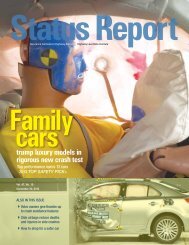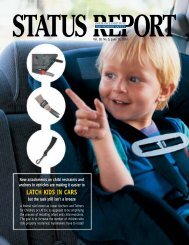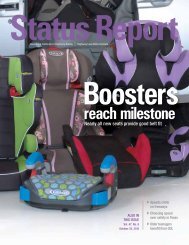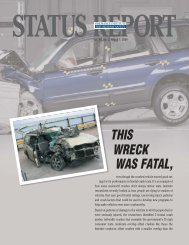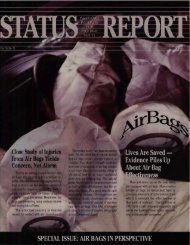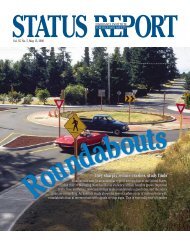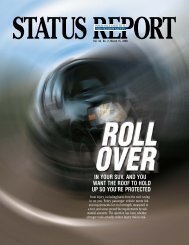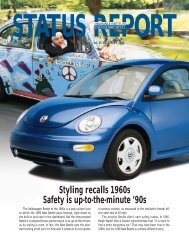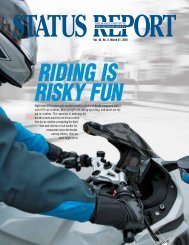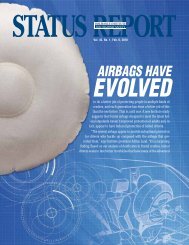IIHS Status Report newsletter, Vol. 47, No. 6, August 14, 2012
IIHS Status Report newsletter, Vol. 47, No. 6, August 14, 2012
IIHS Status Report newsletter, Vol. 47, No. 6, August 14, 2012
Create successful ePaper yourself
Turn your PDF publications into a flip-book with our unique Google optimized e-Paper software.
<strong>Status</strong> <strong>Report</strong><br />
Insurance Institute for Highway Safety | Highway Loss Data Institute<br />
crashes<br />
Small overlap<br />
New consumer-test program<br />
aims for even safer vehicles<br />
Also In<br />
this issue<br />
<strong>Vol</strong>. <strong>47</strong>, <strong>No</strong>. 6<br />
<strong>August</strong> <strong>14</strong>, <strong>2012</strong><br />
4Real-world small overlap frontal<br />
crash results in driver injuries<br />
4ESC proposed as standard feature<br />
for truck tractors, certain buses
The small overlap front test<br />
replicates what happens when<br />
the front corner of a car collides<br />
with another vehicle or<br />
object. Twenty-five percent of<br />
the vehicle’s front end strikes<br />
a 5-foot-tall rigid barrier at 40<br />
mph. A 50th percentile Hybrid<br />
III dummy representing an<br />
average-size male is belted in<br />
the driver seat.<br />
A new Institute crash test evaluates how well vehicles<br />
protect people in frontal crashes involving 25 percent of a vehicle’s<br />
front end. Most cars in this inaugural round earn marginal or poor ratings.<br />
O<br />
nly 3 of 11 midsize luxury and near-luxury cars<br />
evaluated earn good or acceptable ratings<br />
in the Institute’s new small overlap frontal<br />
crash test, the latest addition to a suite of tests designed<br />
to help consumers pick the safest vehicles.<br />
The Acura TL and <strong>Vol</strong>vo S60 earn good ratings,<br />
while the Infiniti G earns acceptable. The<br />
Acura TSX, BMW 3 series, Lincoln MKZ and<br />
<strong>Vol</strong>kswagen CC earn marginal ratings. The Mercedes-Benz<br />
C-Class, Lexus IS 250/350, Audi A4<br />
and Lexus ES 350 earn poor. All of these cars are<br />
<strong>2012</strong> models.<br />
In the test, 25 percent of a car’s front end on the<br />
driver side strikes a 5-foot-tall rigid barrier at 40<br />
mph. A 50th percentile male Hybrid III dummy<br />
is belted in the driver seat. The test is designed<br />
to replicate what happens when the front corner<br />
of a car collides with another vehicle or an object<br />
like a tree or utility pole. Outside of some automakers’<br />
proving grounds, such a test isn’t currently<br />
conducted anywhere else in the United States<br />
or Europe.<br />
“Nearly every new car performs well in other<br />
frontal crash tests conducted by the Institute and<br />
the federal government, but we still see more than<br />
10,000 deaths in frontal crashes each year,” Institute<br />
President Adrian Lund says. “Small overlap crashes<br />
are a major source of these fatalities. This new<br />
test program is based on years of analyzing realworld<br />
frontal crashes and then replicating them<br />
in our crash test facility to determine how people<br />
are being seriously injured and how cars can be designed<br />
to protect them better. We think this is the<br />
next step in improving frontal crash protection.”<br />
The number of drivers of 0-3-year-old passenger<br />
vehicles involved in fatal frontal crashes has fallen<br />
55 percent since 2001. Much of the improved outlook<br />
is due to the success of consumer information<br />
testing like the New Car Assessment Program<br />
begun by the National Highway Traffic Safety Administration<br />
(NHTSA) in 1978 and crashworthiness<br />
evaluations the Institute started in 1995. In<br />
NHTSA’s frontal test, passenger vehicles crash at<br />
35 mph into a rigid barrier covering the full width<br />
2 |<br />
<strong>Status</strong> <strong>Report</strong> — <strong>Vol</strong>ume <strong>47</strong>, Number 6
of the vehicle. In the Institute’s<br />
40 mph offset frontal test,<br />
now called a moderate overlap<br />
frontal test, 40 percent<br />
of the total width of a vehicle<br />
strikes a deformable<br />
barrier on the driver side.<br />
In a 2009 Institute<br />
study of vehicles with<br />
good ratings for frontal<br />
crash protection,<br />
small overlap crashes<br />
accounted for<br />
nearly a quarter of<br />
the frontal crashes<br />
involving serious or<br />
fatal injury to front<br />
seat occupants. Another<br />
24 percent of the<br />
frontal crashes were moderate<br />
overlap crashes, although<br />
they likely occurred at much higher speeds<br />
than the Institute’s moderate overlap test (see <strong>Status</strong><br />
<strong>Report</strong>, March 7, 2009; on the web at iihs.org). An<br />
additional <strong>14</strong> percent occurred when passenger vehicles<br />
underrode large trucks, SUVs or other highriding<br />
passenger vehicles. The Institute is exploring<br />
countermeasures for large truck underride crashes<br />
and in other research has found that the problem<br />
of crash incompatibility between cars and SUVs is<br />
being reduced (see <strong>Status</strong> <strong>Report</strong>, March 1, 2011,<br />
and Sept. 28, 2011).<br />
Structural integrity<br />
The key to protection in any crash is a strong safety<br />
cage that resists deformation to maintain survival<br />
space for occupants. Then vehicle restraint systems<br />
can do their jobs to cushion and protect people.<br />
“It’s Packaging 101. If you ship a fragile item in a<br />
strong box, it’s more likely to arrive at its destination<br />
without breaking. In crashes, people are less vulnerable<br />
to injury if the occupant compartment remains<br />
intact,” Lund explains.<br />
Most modern cars have safety cages built to withstand<br />
head-on collisions and moderate overlap frontal<br />
crashes with little deformation. At the same time,<br />
crush zones help manage crash energy to reduce<br />
forces on the occupant compartment. The main<br />
crush-zone structures are concentrated in the middle<br />
50 percent of the front end. When a crash involves<br />
these structures, the occupant compartment is protected<br />
from intrusion, and front airbags and safety<br />
belts can effectively restrain and protect occupants.<br />
Small overlap crashes are a different story. These<br />
crashes primarily affect a car’s outer edges, which<br />
aren’t well protected by the crush-zone structures.<br />
Lexus IS<br />
Small overlap frontal ratings<br />
Acura TL<br />
<strong>Vol</strong>vo S60<br />
Infiniti G<br />
Acura TSX<br />
sedan/Sport Wagon<br />
BMW 3 series<br />
Lincoln MKZ<br />
<strong>Vol</strong>kswagen CC<br />
Mercedes C-Class<br />
Lexus IS 250/350<br />
Audi A4<br />
Lexus ES 350<br />
Overall<br />
G<br />
G<br />
A<br />
M<br />
M<br />
M<br />
M<br />
P<br />
P<br />
P<br />
P<br />
Lexus IS<br />
Structure<br />
A<br />
G<br />
M<br />
M<br />
M<br />
P<br />
M<br />
P<br />
P<br />
P<br />
P<br />
<strong>Vol</strong>vo S60<br />
Restraints &<br />
kinematics<br />
G<br />
A<br />
G<br />
M<br />
M<br />
M<br />
P<br />
M<br />
P<br />
P<br />
P<br />
Good<br />
G<br />
Dummy injury measures<br />
Head &<br />
neck<br />
G<br />
G<br />
G<br />
G<br />
G<br />
G<br />
G<br />
G<br />
G<br />
G<br />
G<br />
Acceptable<br />
A<br />
Chest<br />
G<br />
G<br />
G<br />
G<br />
G<br />
G<br />
G<br />
G<br />
G<br />
G<br />
G<br />
<strong>Vol</strong>vo S60<br />
Hip &<br />
thigh<br />
G<br />
G<br />
G<br />
G<br />
G<br />
G<br />
A<br />
G<br />
G<br />
P<br />
M<br />
Marginal M<br />
Lower leg<br />
& foot<br />
G<br />
G<br />
G<br />
P<br />
P<br />
A<br />
G<br />
P<br />
P<br />
G<br />
P<br />
Poor P<br />
Survival space<br />
for the driver<br />
wasn’t well<br />
maintained in<br />
the Lexus IS (far<br />
left) crash test.<br />
The A-pillar<br />
bent and<br />
the footwell<br />
collapsed as<br />
the left front<br />
wheel and tire<br />
were forced<br />
rearward. The<br />
dummy’s feet<br />
were entrapped<br />
by intruding<br />
structures.<br />
Results for the<br />
<strong>Vol</strong>vo S60 (near<br />
left) were very<br />
different. The<br />
S60’s occupant<br />
compartment<br />
held up well,<br />
with only minor<br />
intrusion.<br />
<strong>August</strong> <strong>14</strong>, <strong>2012</strong> |<br />
3
The Institute’s new test reflects the severity of real-world small overlap<br />
frontal crashes. The majority of the cars evaluated experienced substantial<br />
occupant compartment intrusion.<br />
BMW 3 series<br />
Mercedes-Benz C-Class<br />
Crash forces go directly into the<br />
front wheel, suspension system and<br />
firewall. It is not uncommon for the<br />
wheel to be forced rearward into the footwell,<br />
contributing to even more intrusion<br />
in the occupant compartment and resulting<br />
in serious leg and foot injuries. To<br />
provide effective protection in small overlap<br />
crashes, the safety cage needs to resist<br />
crash forces that aren’t tempered by crushzone<br />
structures. Widening these front-end<br />
structures also would help.<br />
“These are severe crashes, and our new<br />
test reflects that,” Lund says. “Most automakers<br />
design their vehicles to ace our<br />
moderate overlap frontal test and NHTSA’s<br />
Above: The <strong>Vol</strong>kswagen CC is the first vehicle<br />
the Institute has ever evaluated to lose a door<br />
in a crash test. Top left: Substantial intrusion<br />
in the BMW 3 series meant that left lower<br />
leg injury risk was high. Bottom left: In the<br />
Mercedes-Benz C-Class, the dummy’s right<br />
foot was wedged beneath the brake pedal.<br />
<strong>Vol</strong>kswagen CC<br />
full-width<br />
frontal test, but<br />
the problem of<br />
small overlap crashes<br />
hasn’t been addressed. We hope<br />
our new rating program will change that.”<br />
Vehicle test performance varied widely<br />
in the three rating categories: structure,<br />
restraints and kinematics, and dummy<br />
injury measures. The majority of the cars<br />
had lots of occupant compartment intrusion,<br />
which contributed to their low overall<br />
rating. Occupant motion varied greatly as<br />
well, with the dummy missing the airbag in<br />
some cases. In others, safety belts allowed<br />
the dummy’s head and torso to move too<br />
far forward toward the A-pillar. Forces<br />
measured on the dummy indicated high<br />
risk of injury for the legs and feet in several<br />
vehicles.<br />
Structurally, the <strong>Vol</strong>vo S60 was best.<br />
With only a few inches of intrusion, the<br />
occupant compartment looked much the<br />
same as it did in a prior moderate overlap<br />
4 |<br />
<strong>Status</strong> <strong>Report</strong> — <strong>Vol</strong>ume <strong>47</strong>, Number 6
test. Reinforcement of the S60’s upper rails<br />
and a steel cross member below the instrument<br />
panel helped to keep the safety cage<br />
intact. <strong>Vol</strong>vo has performed similar small<br />
overlap crash tests as part of its vehicle<br />
safety development process since the late<br />
1980s, taking the results into account when<br />
designing new models.<br />
The Lexus IS had up to 10 times as much<br />
occupant compartment intrusion as the<br />
<strong>Vol</strong>vo. In the IS test, the car’s A-pillar bent<br />
and the footwell collapsed as the left front<br />
wheel and tire were forced rearward. The<br />
dummy’s left foot was entrapped by intruding<br />
structure, and its right foot was wedged<br />
beneath the brake pedal. Entrapment also<br />
was an issue with the Mercedes C-Class. The<br />
dummy’s right foot ended up wedged beneath<br />
the brake pedal as the left front wheel<br />
was forced rearward into the footwell.<br />
When the <strong>Vol</strong>kswagen CC was put to<br />
the test, the driver door was sheared off its<br />
hinges. The CC is the first vehicle the Institute<br />
has ever evaluated to completely lose its<br />
door. An open door results in an automatic<br />
downgrade to poor for restraints and kinematics,<br />
as also was the case with the Audi<br />
A4, whose door opened but remained attached<br />
to the car. Doors should stay closed<br />
in a crash to keep people from being partially<br />
or completely ejected from vehicles.<br />
Restraint systems’ key role<br />
Safety belts and airbags are important in any<br />
crash configuration, and they are especially<br />
taxed in small overlap frontal crashes. When<br />
cars strike the test barrier they tend to move<br />
sideways away from it, and the interior structures<br />
including the driver door, side window<br />
and A-pillar move in the same direction. The<br />
test dummy, however, keeps moving forward<br />
into the path of the sideways-moving interior<br />
structures. At the same time, the steering<br />
column and driver airbag move inboard in<br />
many vehicles because of the way the front<br />
end and occupant compartment deform. If<br />
the dummy misses the airbag or slides off it,<br />
the head and chest are unprotected.<br />
Front airbags are calibrated to deploy in<br />
these types of crashes. Side airbags, including<br />
head-protecting curtains and chest-protecting<br />
torso airbags, don’t always deploy<br />
because they are designed mainly for true<br />
side impacts — think so-called T-bone<br />
crashes at intersections. When they do<br />
deploy, they don’t always do so early<br />
Real-world<br />
small overlap crash<br />
results in driver facial injuries<br />
Hollyn Mangione knows first hand the risks of a small overlap<br />
frontal crash. Driving her <strong>2012</strong> Kia Soul to a friend’s house on a<br />
clear evening last <strong>No</strong>vember, Mangione, 48, encountered an oncoming<br />
1999 GMC Yukon that had veered into her lane on a rural<br />
road in Hanover County, Virginia.<br />
“I looked up and saw the other vehicle coming toward me, and I<br />
remember thinking, is there someplace I can go Can I get off the<br />
road I took my foot off the accelerator trying to buy myself some time to make a decision. There<br />
wasn’t anywhere to go on this narrow road because it was tree-lined, and there was a big ditch.<br />
“I remember thinking, please just stay in your lane,” she recalls. “Once I heard the boom and felt<br />
it, I was unconscious.” Afterward, she says “I remember the EMT holding my head and my telling<br />
her, ‘That really hurts.’ And saying to them, ‘But I’m stuck over here where my knee is pinned in the<br />
car.’ And then I don’t remember anything until they were putting IVs in, in the ambulance.”<br />
Mangione, who was using her safety belt, sustained facial injuries from contact with the Kia’s<br />
door frame. She had a left facial fracture and laceration, concussion, whiplash, left eye injury and<br />
dental injuries. Crash damage to Mangione’s small car was similar to damage patterns in the Institute’s<br />
small overlap crash test. The driver’s space was compromised by intruding structure. The A-<br />
pillar, hinge pillar and forward portion of the window frame were driven rearward and inboard as the<br />
wheel and tire were forced rearward. The side curtain and torso airbags didn’t deploy. n<br />
enough or extend far enough forward to<br />
adequately protect people. The result is an<br />
airbag gray zone with gaps between what<br />
front airbags cover and what side airbags<br />
do — if they deploy at all.<br />
Without airbag protection, people in realworld<br />
small overlap frontal crashes can sustain<br />
head injuries from direct contact with<br />
the A-pillar, dashboard or window sill or by<br />
hitting trees, poles or other objects. Chest injuries<br />
happen when people contact the steering<br />
wheel, door or other intruding structures.<br />
Every luxury car and near-luxury car the<br />
Institute evaluated earns good ratings for<br />
head, neck and chest injury risk based on<br />
measurements from the dummy’s sensors.<br />
This is true even though there are many<br />
cases of serious upper body injuries in realworld<br />
crashes with similar vehicle damage.<br />
One possible reason for the differing results<br />
is that real people move more during<br />
a crash and are prone to be out of position<br />
at the start, compared with relatively stiff<br />
and precisely positioned crash test dummies.<br />
<strong>No</strong>t all drivers are the same size as<br />
the dummy or seated exactly the same way.<br />
A close call for the dummy could mean an<br />
actual injury for a person. In several crash<br />
tests, the dummy’s head barely missed the<br />
intruding structure of the vehicle, where<br />
a real person may have made contact and<br />
sustained an injury. Another reason is that<br />
the frontal crash dummy the Institute uses<br />
in the small overlap test is not good at measuring<br />
risks from lateral forces. Side crash<br />
dummies do a better job of this but can’t<br />
“sense” — or record — much of the frontal<br />
action in these tests.<br />
Side curtain and torso airbags deployed<br />
in the Acura TL and <strong>Vol</strong>vo S60, although<br />
the S60’s torso airbag fired too late in the<br />
crash to protect the dummy’s chest from<br />
<strong>August</strong> <strong>14</strong>, <strong>2012</strong> |<br />
5
Lincoln MKZ<br />
Acura TL<br />
Safety belts and airbags<br />
are especially taxed in<br />
small overlap frontal<br />
crashes. Gaps in airbag<br />
coverage or too much belt<br />
slack can leave occupants<br />
vulnerable to injuries.<br />
<strong>Vol</strong>vo S60<br />
Above: The <strong>Vol</strong>vo S60 was a top performer.<br />
The sedan’s occupant compartment<br />
held up better than any of the<br />
other cars. <strong>Vol</strong>vo runs small overlap<br />
crash tests as part of its vehicle safety<br />
development program.<br />
Top left: The test dummy’s head and chest<br />
missed the front airbag as the steering<br />
column moved to the right in the Lincoln MKZ.<br />
The side curtain airbag deployed but didn’t<br />
have sufficient forward coverage to protect<br />
the head. Middle: The Acura TL’s front and<br />
side curtain airbags did a good job of protecting<br />
the dummy’s head.<br />
potential contact with side structures. One or<br />
both of the curtain and torso airbags didn’t<br />
deploy in seven of the cars evaluated. Of<br />
the six curtains that deployed, four didn’t<br />
provide sufficient forward coverage. The<br />
Institute lowered restraint and kinematics<br />
scores if side airbags didn’t deploy or coverage<br />
was lacking.<br />
“Side curtain airbags and torso airbags<br />
are designed to deploy in side impacts,<br />
but they can be beneficial in small overlap<br />
frontal crashes as well,” Lund says. “If<br />
they do deploy, curtain airbags also need to<br />
extend far enough forward to protect the<br />
head from contact with side structures and<br />
outside objects.”<br />
For example, in the Lincoln MKZ test, the<br />
dummy’s head and chest completely missed<br />
the front airbag as the steering column<br />
moved to the right. The side curtain airbag<br />
deployed but didn’t extend far enough forward<br />
to protect the dummy’s head. In comparison,<br />
the Acura TL’s front and side<br />
curtain airbags worked well together to<br />
keep the head from coming close to any stiff<br />
structures or objects that could cause injury.<br />
Engineers at some manufacturers have<br />
indicated that they are adjusting airbag algorithms<br />
to deploy side airbags in small<br />
overlap frontal crashes. Mercedes, for example,<br />
plans changes for the current C-Class.<br />
Another restraint and kinematics issue<br />
Institute engineers flagged was excessive<br />
forward movement of the driver dummy<br />
caused by too much shoulder belt webbing<br />
spooling out of the retractor. This was the<br />
case with the BMW, Mercedes and <strong>Vol</strong>kswagen.<br />
Like most new vehicles, these cars<br />
have safety belts equipped with load limiters<br />
that allow occupants’ upper bodies<br />
to move forward in frontal crashes when<br />
belt loads exceed a specific threshold. Load<br />
limiters allow some belt spoolout after the<br />
initial impact to reduce belt-force-related<br />
thoracic injuries such as rib fractures by<br />
allowing people to “ride down” deflating<br />
front airbags. However, too much spoolout<br />
can compromise belt effectiveness by allowing<br />
belted occupants to move enough to<br />
strike hard surfaces inside the vehicle. This<br />
concern is greater in small overlaps where<br />
occupants may load only a small part of the<br />
front airbag or miss it completely.<br />
Tougher award criteria<br />
The Institute’s TOP SAFETY PICK award<br />
recognizes passenger vehicles that do the<br />
best job of protecting people in front, side,<br />
rollover and rear crashes based on ratings<br />
in Institute evaluations. The front rating is<br />
based on the moderate overlap test.<br />
The Institute plans to make the top award<br />
criteria more stringent by adding the small<br />
overlap frontal test to its battery of evaluations.<br />
The existing criteria will continue for<br />
the 2013 award cycle, but vehicles that excel<br />
in the new test will be recognized.<br />
“We won’t have evaluated many vehicles<br />
in the small overlap test in time for the<br />
2013 award,” Lund explains. “Models meeting<br />
the current award criteria still offer outstanding<br />
protection in most crashes, and<br />
they will continue to earn TOP SAFETY<br />
PICK in 2013. However, those vehicles that<br />
also do well in the new test will get to claim<br />
a higher award level that will be announced<br />
later this year.”<br />
The Institute has tightened award criteria<br />
twice since the first winners were announced<br />
for 2006 models. Good rear test<br />
results and availability of electronic stability<br />
control became a requirement starting with<br />
2007 models, and a good roof strength rating<br />
became a deciding factor for 2010 models<br />
(see <strong>Status</strong> <strong>Report</strong>, March 24, 2009). Stability<br />
control is no longer a separate requirement<br />
since all <strong>2012</strong> and later vehicles must have<br />
the feature as standard under federal rules.<br />
Automakers have been quick to rise to<br />
the occasion whenever the Institute has<br />
added a new evaluation to its vehicle test<br />
program, and the small overlap test should<br />
be no exception.<br />
“Manufacturers recognize that this crash<br />
mode poses a significant risk to their customers<br />
and have indicated that they plan<br />
structural and restraint changes to improve<br />
protection in small overlap frontal crashes,”<br />
Lund says.<br />
Next, the Institute will assess midsize<br />
moderately priced cars, including such topselling<br />
models as the Ford Fusion, Honda<br />
Accord and Toyota Camry. n<br />
6 |<br />
<strong>Status</strong> <strong>Report</strong> — <strong>Vol</strong>ume <strong>47</strong>, Number 6
Truck tractors, buses<br />
could get standard ESC<br />
under NHTSA proposal<br />
Electronic stability control (ESC), a crash avoidance feature required<br />
on <strong>2012</strong> and newer model passenger vehicles, could become<br />
standard on new large truck tractors and certain large buses if the<br />
National Highway Traffic Safety Administration (NHTSA) adopts<br />
a proposed rule announced in May.<br />
Analysis of the real-world experience of ESC indicates the technology<br />
is saving lives by helping to prevent rollovers and loss-of-control<br />
crashes in cars, minivans, pickups and SUVs (see <strong>Status</strong> <strong>Report</strong>, Sept.<br />
28, 2011; on the web at iihs.org). Researchers haven’t yet been able to<br />
quantify ESC’s real-world effect for large trucks.<br />
NHTSA has been conducting extensive research on stability control<br />
systems for truck tractors and large buses<br />
since 2006. The agency has sponsored<br />
studies of crash data to help examine the<br />
potential safety benefits, conducted test<br />
track studies to understand how the systems<br />
respond in different maneuvers,<br />
and undertaken simulator evaluations<br />
to understand how drivers might use<br />
the systems. NHTSA also has evaluated<br />
data on dynamic test maneuvers from<br />
truck makers and brake suppliers. The<br />
agency used this information to develop<br />
test maneuvers that define what systems<br />
must do to comply with the proposed<br />
regulation and to predict the effectiveness<br />
of stability control systems.<br />
The agency estimates that ESC on<br />
truck tractors could prevent 40 to 56<br />
percent of untripped rollovers and an<br />
additional <strong>14</strong> percent of loss-of-control crashes each year. Requiring<br />
ESC for all truck tractors and certain buses with a gross vehicle rating<br />
of more than 26,000 pounds would prevent as many as 2,329 crashes and<br />
as many as 858 injuries, plus save as many as 60 lives annually. NHTSA<br />
based its estimates for truck tractors and large buses on an initial target<br />
crash population of 10,313 crashes (5,510 rollovers and 4,803 loss-ofcontrol<br />
crashes), 327 fatalities (111 rollover and 216 loss of control)<br />
and 3,358 injury crashes (2,217 rollover and 1,<strong>14</strong>1 loss of control).<br />
There are two kinds of stability control systems available for truck<br />
tractors: ESC and roll stability control. Roll stability control systems<br />
automatically intervene if sensors monitoring a truck tractor’s lateral<br />
acceleration and wheel speed detect a high rollover risk. Tractorbased<br />
systems can selectively apply brakes on the tractor’s drive axle<br />
and the trailer, plus modulate engine power to slow down the truck<br />
and keep it upright. Trailers can have roll stability control, too, but<br />
trailer systems only control trailer brakes, not the tractor’s, and<br />
can’t reduce engine power. Roll stability control can reduce rollovers<br />
but isn’t meant to help drivers maintain directional control.<br />
That ability is unique to ESC.<br />
ESC incorporates all of the features of roll stability control but<br />
with the added benefit of a steering-angle sensor and a yaw sensor to<br />
measure the tractor’s directional stability. These sensors help mitigate<br />
severe oversteer and understeer conditions. If measures exceed specific<br />
thresholds, ESC reduces engine power and can selectively apply brakes<br />
on multiple tractor axles in order to bring the vehicle back into line,<br />
plus apply the trailer brakes as needed to slow down the truck.<br />
“We support NHTSA’s decision to require ESC rather than roll stability<br />
control,” says Anne McCartt, Institute senior vice president for<br />
research. “Although it’s more costly, ESC affects a wider range of rollover<br />
and loss-of-control collisions than roll stability control.”<br />
About 26 percent of <strong>2012</strong> model truck tractors and 80 percent of<br />
new buses have ESC, NHTSA estimates. If adopted, the rule would<br />
take effect within two years of publication. The agency isn’t requiring<br />
in-service truck tractors and buses to be retrofitted but seeks<br />
comments on a future ESC retrofit mandate.<br />
Single-unit trucks aren’t included in the current proposal because<br />
NHTSA needs to determine how effective ESC would be for<br />
these vehicles. The agency plans a feasibility study and could consider<br />
a future ESC requirement. Estimating the technology’s potential<br />
benefits for single-unit trucks is challenging, NHTSA says.<br />
Compared with truck tractors, the single-unit truck fleet varies by<br />
model in terms of weight, wheelbase, axles, cargo type and other factors<br />
that affect the calibration and performance of stability control<br />
systems. Another issue is that because multiple suppliers handle the<br />
design and building of each vehicle, chassis suppliers who fit brakes<br />
and potentially stability control often don’t know the vehicle’s ultimate<br />
function. NHTSA also notes that stability control systems are<br />
more widely available for air-braked vehicles, including truck tractors,<br />
than for hydraulic-braked single-unit trucks. Only about 1 percent<br />
of new single-unit trucks have these systems now, NHTSA says.<br />
“We commend the agency for moving ahead with an ESC mandate<br />
for new truck tractors and large buses independent of its ongoing<br />
research on single-unit trucks,” McCartt says. “We encourage<br />
NHTSA to expedite this research and also to explore the feasibility<br />
of a retrofitting requirement so a bigger proportion of the fleet benefits<br />
from ESC.” n<br />
<strong>August</strong> <strong>14</strong>, <strong>2012</strong> |<br />
7
<strong>Status</strong> <strong>Report</strong><br />
Small overlap test results42<br />
Real-world crash45<br />
ESC for truck tractors<strong>47</strong><br />
<strong>Vol</strong>ume <strong>47</strong>, Number 6<br />
<strong>August</strong> <strong>14</strong>, <strong>2012</strong><br />
1005 N. Glebe Road<br />
Arlington, VA 22201 USA<br />
t 703/2<strong>47</strong>-1500<br />
f 703/2<strong>47</strong>-1588<br />
Inquiries/print subscriptions:<br />
<strong>Status</strong><strong>Report</strong>@iihs.org<br />
Copy may be republished with<br />
attribution. Images require<br />
permission to use.<br />
Editor: Kim Stewart<br />
Writer: Sarah Karush<br />
Art Director: Steve Ewens<br />
www.iihs.org<br />
iihs.org/rss<br />
youtube.com/iihs<br />
@<strong>IIHS</strong>_autosafety<br />
m.iihs.org<br />
This publication is printed on recycled paper.<br />
The Insurance Institute for Highway Safety is an independent, nonprofit scientific and educational organization dedicated<br />
to reducing the losses — deaths, injuries and property damage — from crashes on the nation’s roads.<br />
The Highway Loss Data Institute shares and supports this mission through scientific studies of insurance data representing<br />
the human and economic losses resulting from the ownership and operation of different types of vehicles and by publishing<br />
insurance loss results by vehicle make and model.<br />
Both organizations are wholly supported by the following auto insurers and funding associations:<br />
Member groups<br />
Acceptance Insurance<br />
ACE Private Risk Services<br />
Affirmative Insurance<br />
Agency Insurance Company of Maryland<br />
Alfa Alliance Insurance Corporation<br />
Alfa Insurance<br />
Allstate Insurance Group<br />
American Family Mutual Insurance<br />
American National Family of Companies<br />
Ameriprise Auto & Home<br />
Amica Mutual Insurance Company<br />
ARI Insurance Companies<br />
Auto Club Enterprises<br />
Auto Club Group<br />
Bankers Insurance Group<br />
Bituminous Insurance Companies<br />
California Casualty Group<br />
California State Auto Group<br />
Capital Insurance Group<br />
Chubb & Son<br />
Colorado Farm Bureau Mutual Insurance Company<br />
Concord Group Insurance Companies<br />
Cotton States Insurance<br />
COUNTRY Financial<br />
Direct General Corporation<br />
Discovery Insurance Company<br />
Driver’s Insurance Group<br />
Erie Insurance Group<br />
Esurance<br />
Farm Bureau Financial Services<br />
Farm Bureau Insurance of Michigan<br />
Farm Bureau Mutual Insurance Company of Idaho<br />
Farmers Insurance Group of Companies<br />
Farmers Mutual Hail Insurance Company of Iowa<br />
Farmers Mutual of Nebraska<br />
Fireman’s Fund Insurance Company<br />
Florida Farm Bureau Insurance Companies<br />
Frankenmuth Insurance<br />
Gainsco Insurance<br />
GEICO Group<br />
Georgia Farm Bureau Mutual Insurance Company<br />
GMAC Personal Lines Insurance<br />
Grange Insurance<br />
Hallmark Insurance Company<br />
Hanover Insurance Group<br />
The Hartford<br />
Haulers Insurance Company, Inc.<br />
Homeowners of America Insurance Company<br />
Horace Mann Insurance Companies<br />
ICW Group<br />
Imperial Fire & Casualty Insurance Company<br />
Indiana Farmers Mutual Insurance Company<br />
Infinity Property & Casualty<br />
Kemper Preferred<br />
Kentucky Farm Bureau Insurance<br />
Liberty Mutual Insurance Company<br />
Louisiana Farm Bureau Mutual Insurance Company<br />
Maryland Automobile Insurance Fund<br />
Mercury Insurance Group<br />
MetLife Auto & Home<br />
MiddleOak<br />
Mississippi Farm Bureau Casualty Insurance Company<br />
MMG Insurance<br />
Mutual of Enumclaw Insurance Company<br />
Nationwide<br />
New Jersey Manufacturers Insurance Group<br />
NLC Insurance Companies, Inc.<br />
<strong>No</strong>dak Mutual Insurance Company<br />
<strong>No</strong>rfolk & Dedham Group<br />
<strong>No</strong>rth Carolina Farm Bureau Mutual Insurance Company<br />
<strong>No</strong>rthern Neck Insurance Company<br />
Old American County Mutual Fire Insurance<br />
Old American Indemnity Company<br />
Oregon Mutual Insurance<br />
Pekin Insurance<br />
PEMCO Insurance<br />
Plymouth Rock Assurance<br />
Progressive Corporation<br />
The Responsive Auto Insurance Company<br />
Rockingham Group<br />
Safeco Insurance<br />
Samsung Fire & Marine Insurance Company<br />
SECURA Insurance<br />
Sentry Insurance<br />
Shelter Insurance<br />
Sompo Japan Insurance Company of America<br />
South Carolina Farm Bureau Mutual Insurance Company<br />
Southern Farm Bureau Casualty Insurance Company<br />
State Auto Insurance Companies<br />
State Farm<br />
Tennessee Farmers Mutual Insurance Company<br />
Texas Farm Bureau Insurance Companies<br />
Tower Group Companies<br />
The Travelers Companies<br />
United Educators<br />
USAA<br />
Utica National Insurance Group<br />
Virginia Farm Bureau Mutual Insurance<br />
West Bend Mutual Insurance Company<br />
Young America Insurance Company<br />
Zurich <strong>No</strong>rth America<br />
Funding associations<br />
American Insurance Association<br />
National Association of Mutual Insurance Companies<br />
Property Casualty Insurers Association of America



